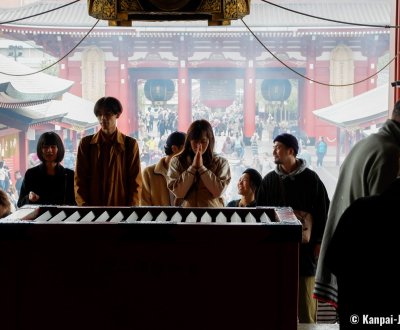Good Practices When Visiting Temples and Shrines
🙏🏻 Worshipping Etiquette in Japan
Shinto shrines and Buddhist temples are sacred sites in Japan and are ruled by a set of practices and rituals largely followed within the society. As a foreign tourist, knowing the good behavior and how to pray the local deities allows for a better understanding and a more respectful visit of these religious grounds.
Any traveler in Japan visits at least 1 temple or shrine during their trip. These religious compounds, open to every one and widely spread throughout the archipelago, are at the core of the Japaneses’ daily life and yearly events, and they visit them quite often. An appropriate behavior is key to best enjoy these places’ spirituality and beauty, so we have listed the good practices when visiting a Shinto shrine or a Buddhist temple, along with some hints to know the differences between these places of worship.
Whether the visitor is an adult or a child, quietness is expected when entering a sacred site. Speaking loudly, running, dancing or jumping are therefore inappropriate behaviors (except during specific celebrations). In places where contemplation is a thing, visitors too young to behave may be refused admission. It is also recommended to avoid going to the shrine when sick or at a bereavement time.
On the other hand, clothing is not submitted to a particular code but it is recommended not to wear revealing clothes (like crop tops, swim suits, tight shorts, etc.) and rather choose an outfit which is appropriate for visiting a place of worship. For example, on can wear a light shirt in summer to cover the shoulders. If wearing a hat or a cap, it is better to take it off when entering inside a pavilion. Moreover, visiting a shrine or a temple wearing a kimono 👘 is an activity the Japanese love to do, as a couple or with friends.
As a general rule, pictures are allowed outdoor (pavilions’ architecture, Japanese gardens), but often prohibited indoor: the images of the most sacred Buddhas, placed behind the altar for example, cannot be shot without a prior authorization. It is also best to avoid taking pictures, and especially portraits, of miko priestesses working at the shrine and of the praying monks.
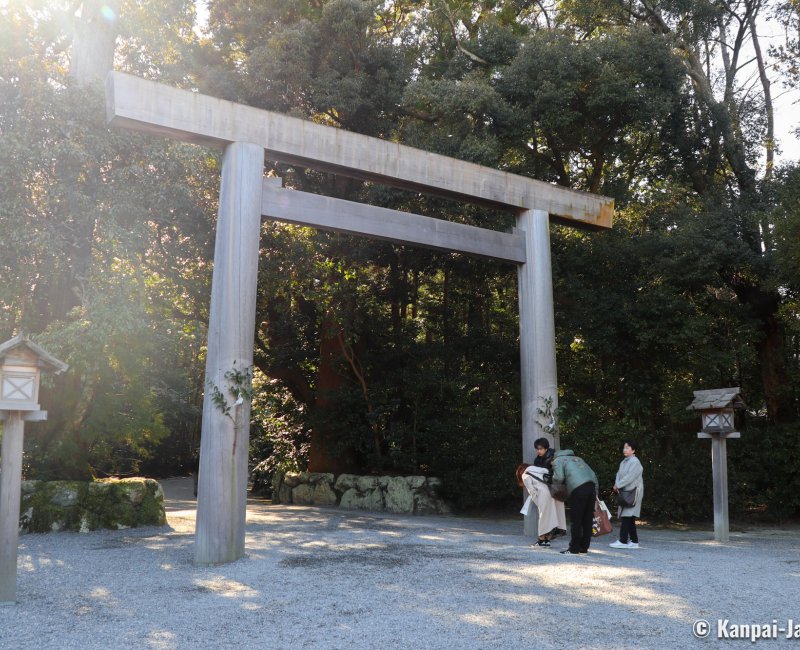
⛩️ Entering the sacred grounds
Standing at the entrance of a Shinto shrine, the tall torii ⛩️ gate, made of wood and painted in a red vermilion, or in grey stone or concrete, is specific to Japan. It separates the sacred area from the secular one. It is good, before crossing its threshold, to bow and walk on one of the sides. The space at the center of the torii, while it is not specifically indicated, is reserved for the deities and priests during official ceremonies.
The entrance of a Buddhist temple is marked by an impressive sculpted wooden gate called -mon. On each side of it, 2 large statues displaying a wrathful look and an intimidating stance represent the Niô guardians, that protect the sacred site from demons and evil spirits. The threshold is often symbolized by a wooden beam on the ground, that must be crossed without stepping on it. A wooden footbridge may be placed to help elderly visitors or persons with a reduced mobility.
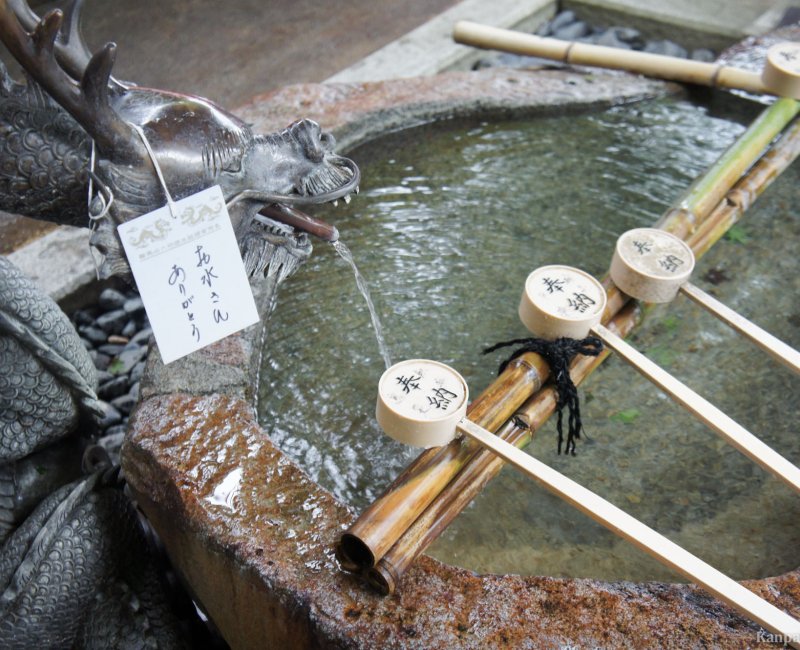
⛲ Ritual purification
Right after the entrance of the spiritual enclosure, visitors are invited to purify at a pavilion called chôzuya or temizuya (手水舎), sheltering a large stone basin that receives the water of a spring 🌸 and often decorated with a dragon. The complete ablutions include several steps:
- Take the ladle with the right hand, fill it with a large amount of water and pour a little on the left hand;
- Then, take the ladle with the left hand and pour water on the right hand;
- Pass back the ladle in the right hand, form a cup with the left hand and pour water into it, and wash the mouth. Do not drink and discreetly spit the water, but not in the basin;
- Then, wash again the left hand as it has touched the mouth;
- Lastly, wash the ladle's shaft by making it stand vertically, for the next person to use it.
On a daily basis, Japanese people have simplified this ritual and only wash their hands, and don’t wash their mouth. Since the advent of Covid 🦠, for sanitary reasons, the purification etiquette has been further lightened: ladles have been removed and one just wash hands without touching anything.
Two important things are to be remembered: the water used for ablutions must not be poured into the overflowing water basin also used by the other visitors. It is important to make sure water is evacuated outside of it, towards the grounds and the drainage settings built for this purpose. Additionally, a chozuya pavilion is not to be used to drink or as a supply of fresh water. The drinks vending machines and the public toilets 🚽 are here for these purposes.
Linked to Shinto cult and therefore primarily existing at the shrines, the water purification also spread to the temples, along with incense and fire 🔥 purification that are specific to Buddhism.
A massive incense burner is usually placed in front of the main hall of a Buddhist temple, to receive senkô (線香) incense sticks lit up by visitors for about ¥100 (~US$0.64). Incense purification consists of "bathing" in the fragrant smoke, which is said to also have medicinal properties, before going to pray. Sometimes, candles are also available, to lit and place on a dedicated display, to honor Buddha or deceased relatives.
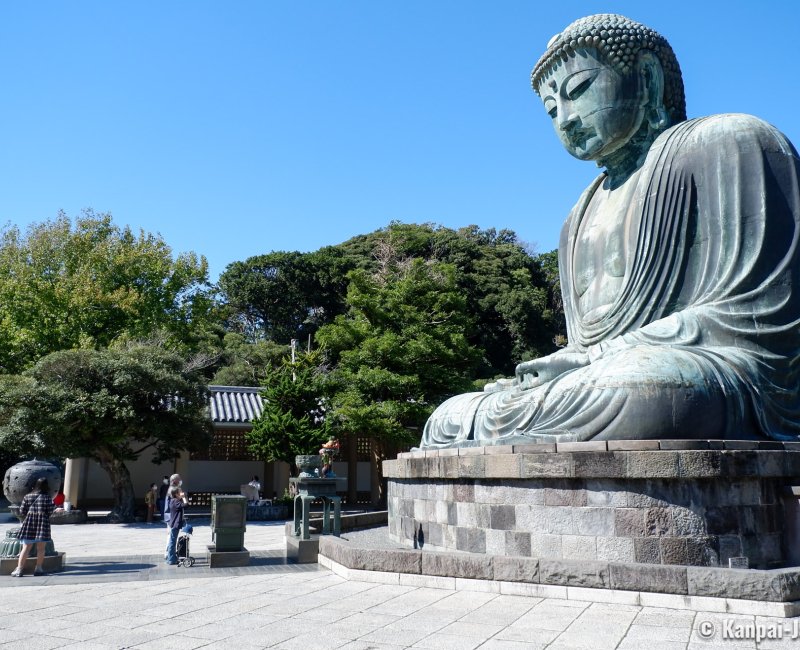
🙏🏻 How to pray the deities?
For both religions, the act of praying does not consist of a unilateral request to a deity, but is rather a way to pay homage, respect it or greet it with the idea of benefiting from its benevolence later. Thus the Japanese term is sanpai (参拝) that could be translated as "paying a visit" or "showing gratitude" to say that one goes praying at the temple or the shrine.
The Japanese therefore pray their deities according to their profiles and their needs in their daily lives, at work, for family or love for example. They take a moment for recollection in front of the worshipping pavilion haiden (拝殿) that is preceding the main hall honden (本殿) closed to the public in the Shinto architecture; or in Buddhist temples, in front of the main building kondo or Buddha's pavilion butsuden. They wait for their turn to step in front of the offering box and carry out the following gestures in a specific order.
At the shrine:
- First throw a ¥5 (~US$0.03) coin in the box as an offering. In Japanese, this coin is called go-en which sounds like the words "luck", "fate" or "relationship";
- Gently ring the bell 2 or 3 times if there is one;
- Slightly bow 2 times;
- Clap hands twice (sometimes 4 times such as in Izumo Taisha) to make sure the kami hear the prayer;
- Join hands together to pray, and focus on your thoughts, without speaking aloud;
- Bow again in a final greeting.
At the temple, only offering money, bowing 2 times and joining hands for a silent prayer are necessary. Those who would like to stay longer in front of the main pavilion should move to the side to let the other people pray in turn. On a side note, the bell in Buddhist enclosures, sheltered in a bell tower called shoro, is normally only used by the monks but can be accessible to the public on special events.
Note that there is no obligation to pray when visiting a temple or a shrine. Provided a respectful demeanor, tourists or non-believers are admitted as observers.
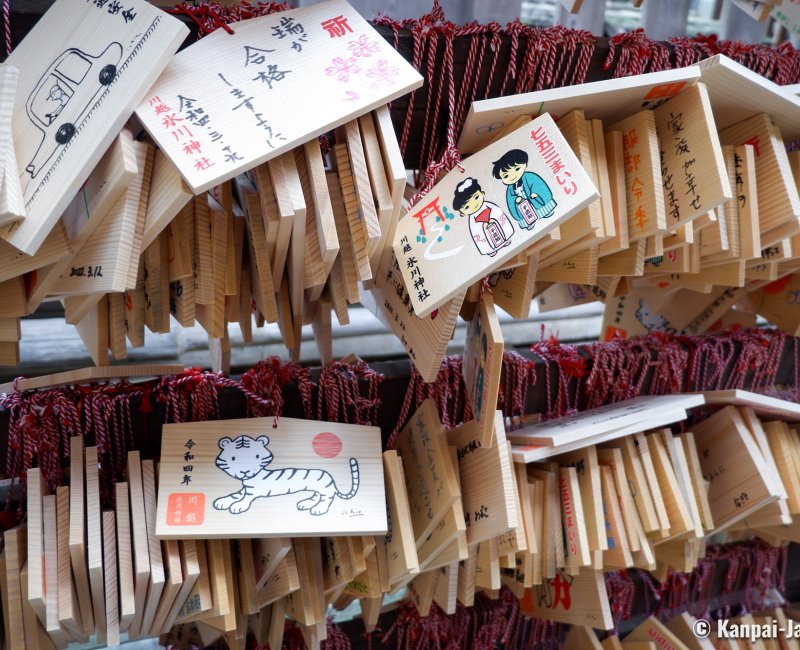
🎋 Make a wish and attract good luck
After the recollection is done, move to the pavilion dedicated to selling protection amulets. They are staffed by miko priestesses dressed in red and white at shrines, and by Buddhist monks at temples, and even sell traditional cult items that can be found everywhere. These lucky-charms, that can be compared to merchandising for worshippers, are also part of the funding for staff and buildings’ maintenance.
Ema (絵馬) votive plates
They are clear wood votive plates that can be bought for ¥500 (~US$3.22) on average. On the back, one writes or draws a wish, a thanks or a goal to reach. For the message to be transmitted to the gods, the plate must be hanged to a dedicated rack with the other ema. Each spiritual site produces its own ema, with a beautifully illustrated front to highlight the particularities of said shrine or temple, or the Chinese zodiac sign of the current year. Foreign tourists can also buy ema as collectible souvenirs.
Predictions on omikuji (おみくじ) paper strips
Omikuji are horoscope paper strips to draw for about ¥100 (~US$0.64) from a large box or with numbered stick corresponding to a drawer to open. The prediction can range anywhere from very positive to very negative. The foretelling, often quite metaphorical, is detailed by larger topic: love, money, health, travel, real estate or even ongoing legal cases, etc. The most touristic places offer English translations but most of the omikuji are written in Japanese.
When drawing a negative foretelling, fold the paper lengthwise in 4 and tie it to one of the ropes intended to leave it behind you. The positive ones are to be kept as they are considered lucky items.
Decorative omamori (お守り) charms
These colorful fabric amulets are used to protect the one carrying it against bad luck, and to bring good fortune in important matters in life, such as taking exams, happiness in love, wealth and a fulfilling work. Specific omamori also give protection for a safe childbirth or for road safety.
Of an average price ranging from ¥300 (~US$1.93) to ¥1,000 (~US$6.44), the amulet is individual and blessed by priests and should be hanged to a bag, or in a place related to the thing the amulet is supposed to protect. This lovely little fabric pouch is closed by a knot and must not be opened, as it would break the charm. It is effective during 1 year, after which it should be replaced by a new one.
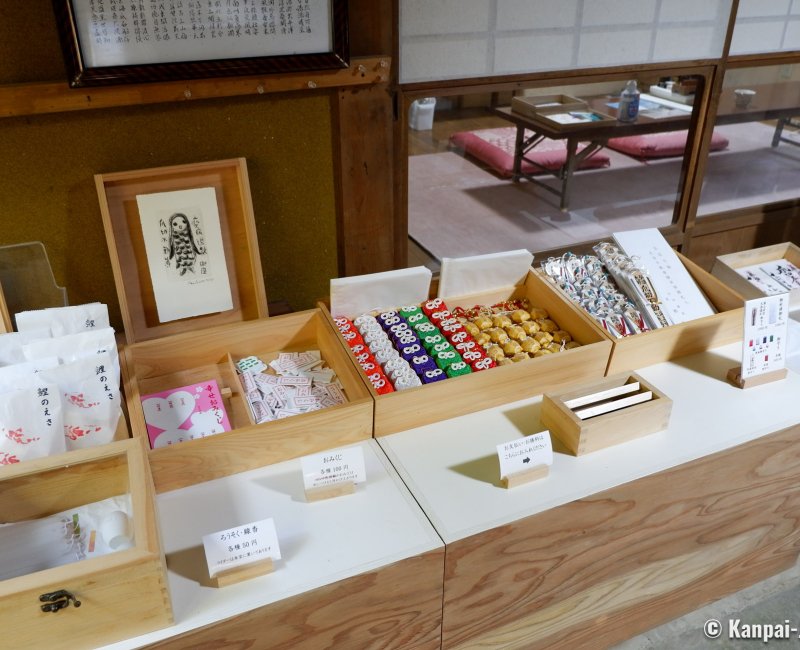
Ofuda (御札) display amulets
Lesser known by foreign travelers, the ofuda talismans are long and narrow wooden plate covered with paper, on which the name of the spiritual site and a prayer are written in kanji characters.
The ofuda prices range on average from ¥500 (~US$3.22) to ¥10,000(~US$64.36). The ofuda stick is to be displayed at a private property in a visible place: hanged on a wall or at the entrance. As a matter of fact, it is a collective protection for a home or a company for example, contrary to the omamori which is an individual protection.
Daruma (だるま) dolls
Daruma dolls can only be found at temples. They portray Bodhidharma, the founder of Zen Buddhism. The pupils are left white and are to be painted at specific times: one when making a wish, and the second one when the wish is fulfilled thanks to one’s efforts and dedication.
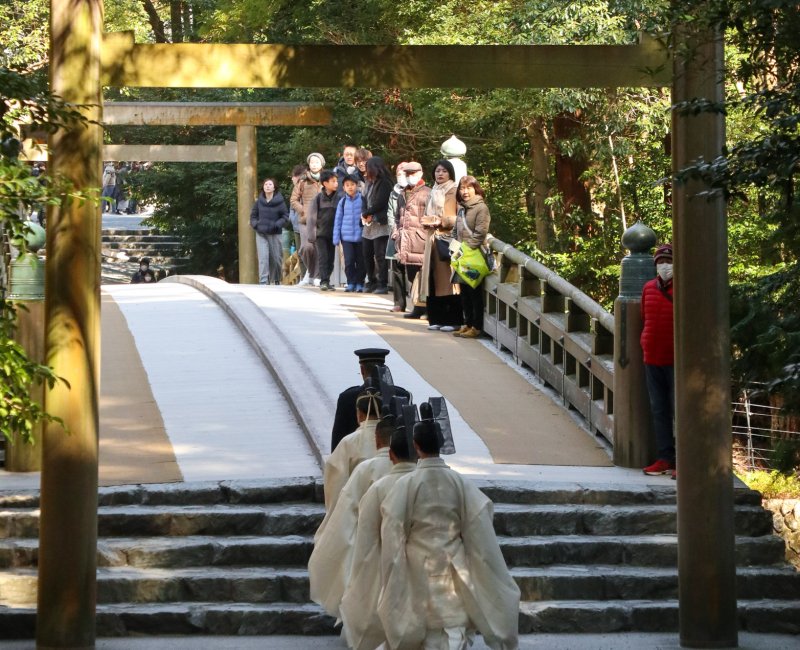
🛐 Is visiting inside the pavilions possible?
Visiting inside the buildings is mainly possible at the temples, where doors are at least open for visitors to admire an inner garden or authentic indoor decorations, such as paintings on fusuma doors. Sites with an indoor dedicated place for contemplation also often serve a matcha tea with seasonal traditional confectionery.
When entering such place, take off your shoes and walk in socks, needless to say the spotless socks as possible as a display of respect. In summer, walking barefoot can be allowed, however it is recommended to always have a spare pair of clean socks just in case.
Generally speaking, the inside of Shinto pavilions is only accessible to the priests and no visitor is allowed, except upon reservation on a few special days throughout the year, such as an important matsuri. Therefore, in Shinto grounds, one simply admire the buildings’ architectural styles from outside, and the natural setting.
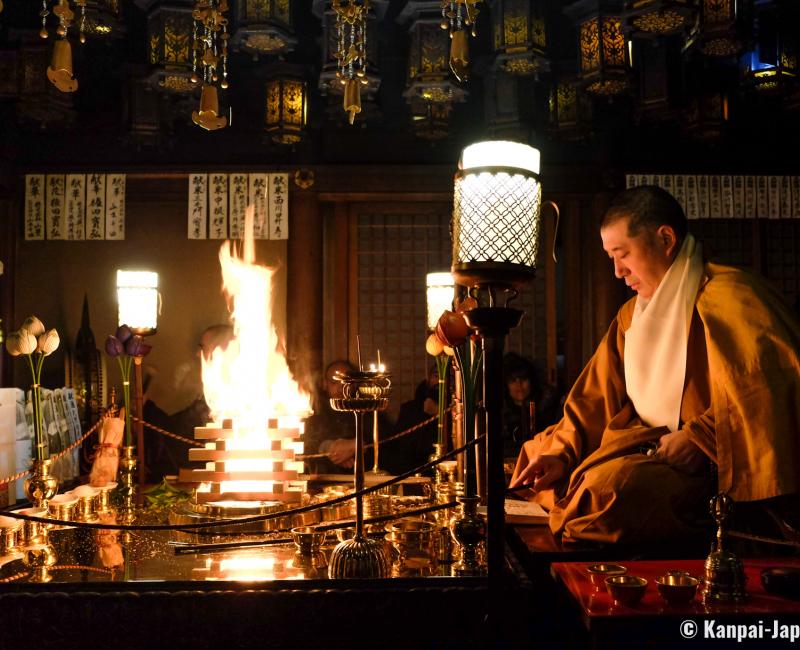
🙇🏻 Taking part to a religious celebration
It is not really possible to take part into a Shinto ritual, as it is most of time a private event, with few people and members of the same family or the same company. However, the pavilions being often opened on the outside, it is possible to watch an ongoing celebration from afar. Then, one must keep silent and taking pictures is forbidden so as not to disturb the participants.
In the largest Shinto shrines’ grounds, especially on the weekends, encountering couples wearing traditional wedding kimono, arriving or leaving their Shinto wedding ceremony is frequent. It is usually possible to take pictures, provided one does not interfere with the couple’s party, their relatives or the shrine’s staff duty to accompany them. Likewise, milestone rituals such as Shichi-go-san are the occasion to encounter dressed up families. Shinto priests can be spotted during ritual processions for annual events part of the Shinto cult. As the Shinto ritual calendar stays the same over the years, planning a visit at such an interesting time is easy.
In temples, it is possible to attend Buddhist ceremonies that are held regularly and at specific hours, or for special occasions. You can silently sit (sometimes kneel in the seiza position) and put your smartphone 📱 on silent mode to listen to the sutra chanting, paced by the sound of a drum. This kind of experience, while mystical, relaxing and worth the time it takes, is however not recommended when visiting with young children.
Another occasion to take part to a celebration is to stay over at the temple (shukubo) to attend the morning Buddhist ritual, with a meditation session and a Goma fire ritual.
The Japanese people are quite open-minded towards religions, but they can be very superstitious and very careful on how to behave in temples and shrines, so as to avoid any faux-pas that would disturb the enshrined deity.

